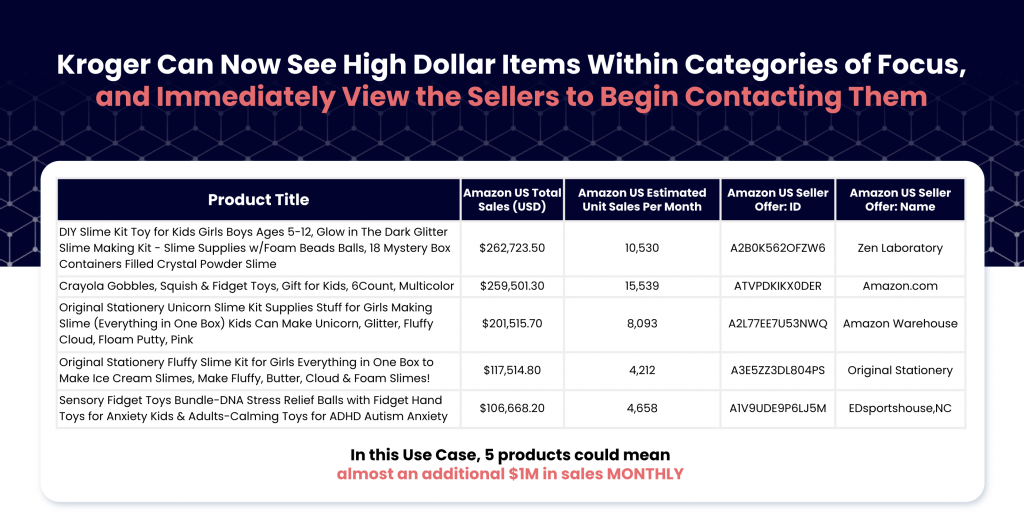Imagine visiting your favorite eCommerce marketplace, where you search for an item you’d like to research or purchase, and land on a particular category page where all you see is the same item listed multiple ways with incomplete information. Immediately, you want to run or leave the website because you think your credit card is about to be compromised on a fraudulent online store.
Online assortment is incredibly important for marketplaces, but how are they dealing with presenting the most relevant items, especially without compromising their product listing data?
On December 8, 2021, during a live webinar, we dove into the most popular ways our team works with major marketplaces, starting with the importance of catalog integrity as the foundation of any marketplace business, leading into insights around demand and product analysis, and diving into finding the right assortment. Read the transcript below and watch the accompanying video.
Finding the Assortment Opportunity in the Data
According to Salesforce, over 75% of consumers actually expect to see new items on a marketplace monthly. So this data point shows how important assortment really is in the lens of shoppers. But the question is how are marketplaces ultimately doing this? And not just find the right assortment, but also take advantage of a major opportunity around cross-selling?
Well, you need to have data on your current customers, understand what are the items they’re typically buying, and data to understand what are ancillary items that they might want to buy (in order to group with that initial purchase). So if someone is buying a swimming pool, I would suggest swimming pool toys for the kids, and any other items that might accompany that purchase. Amazon actually makes about 35% of its revenue directly from cross-selling. So this is a huge opportunity for marketplaces.
They really need the data to make these suggestions interesting and relevant for their customers. But what are some challenges around assortment optimization? Here’s what I’ve learned in working with diverse marketplaces over the years:
- Assortment lives within multiple functions of marketplace organizations. So, it’s not centralized.
- There are multiple teams with this role and responsibility.
- Marketplaces don’t have the right data and tools to help effectively and efficiently.
What’s more, marketplaces are doing this in a very, very manual way: by looking at competitive marketplaces, other websites where they have interesting items, trying to find and figure out what items they’re missing, trying to find and figure out which sellers can ultimately source those items to their marketplaces. So, it’s an incredibly fragmented and also an incredibly manual process today. So what do marketplaces ultimately need to make this a successful endeavor?
There are two things: No.1, centralize and make this a function of one role, so a key stakeholder can manage the process. No. 2, good data and analytics to help make these decisions quickly and efficiently.
Demand and Product Analysis Use Cases
So, let’s take an example of what this actually looks like in real life. Kroger has a printer category on its marketplace. However, the only item it had on its marketplace in the printer category was a single item of printer paper. But, if I was in the market to buy a new printer I would be leaving this site to convert elsewhere if they only have paper.
That said, if you’re going to be a marketplace that is selling in the printers category, you should also have printers and printer ink, in addition to the paper, which is certainly important. But what about including different sizes of paper for example?
But by leveraging the right data, we were able to see that while Kroger has this one item, this item across other marketplaces sells about $10,000 in volume. The sales from this one item are great, but what we also can tell is that there’s another 4,200 or so items that exist within this printer category. And if Kroger were to upload those missing items, they can potentially gain about $150 million per month in this category.
While we’re not suggesting a marketplace bring on every single item in a category, it is crucial to understand what are the best-selling items within a category and quickly be able to upload those items to your marketplace in an effective manner.
In a second example, we can see that the Kroger marketplace also has a toys category. However, when digging into that toys category, we noticed that they were actually missing the five best-selling items within the toys category.

What you can see pictured here is just these five items, over the course of one month are about $106,000 monthly with the highest volume being $260,000 in volume. If Kroger were to upload just these five items (and gain the right Seller Intelligence) in this single category, it could potentially mean up to $1 million dollars in sales monthly. This is why using data to make decisions around assortment is incredibly important.
Understand the Top-Selling Brands with the Right Data
Another opportunity for marketplaces is to think through their categories similar to category advisors throughout retailers. So not only what are the best SKUs and items that are selling, or the best brands, but I also want to understand what are the attributes that are most popular within a category.
In another example, we looked at shampoo and conditioners, finding that color treated (or dyed) hair, and damaged hair resulted for a large percentage of this category. For this, a marketplace should focus on adding items with attributes showing ingredients of shampoo and conditioners that are very popular, like Argan Oil, Organic or Paraben Free.
In one last example, we noticed that within five categories, one marketplace had about 7,000 items listed on its site. However, we could see about 35,000 items in our data, which could have resulted in about $28 million per month in increased sales.
In closing, the idea here is not to upload every single item to a marketplace that exists, the idea here is to understand what are the top-selling brands and items across channels that your marketplace might currently be missing and quickly be able to identify who can sell and source those items, for GMV growth.
Once your catalog is built, be sure to promote the most relevant products with the most informed, competitive pricing – and learn what might be missing from your mix of products that can accelerate growth. Once this is in place, it’s time to figure out the characteristics of A+ sellers that are right for your marketplace.





No comment yet, add your voice below!